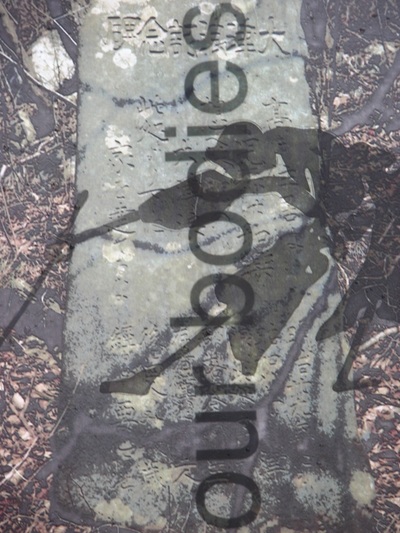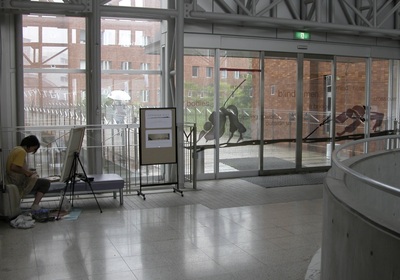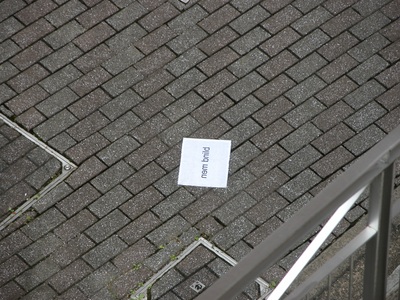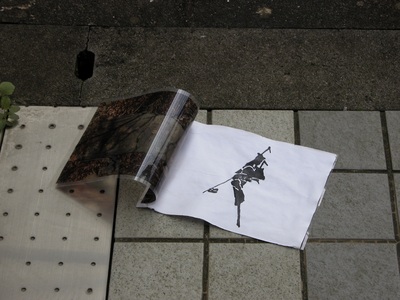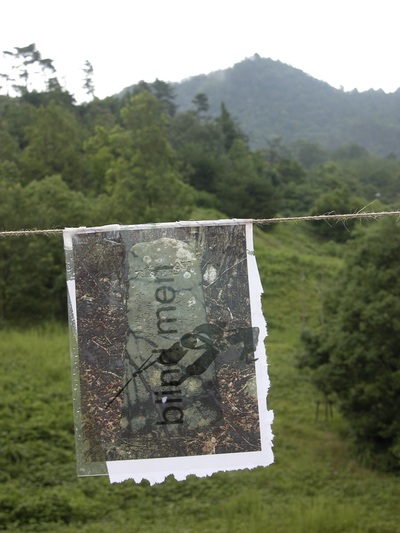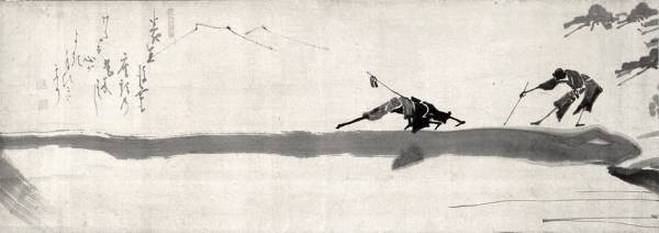CROSSING OVER (AFTER HAKUIN)
Hiroshima City University
Hiroshima, Japan
July 2011
(scroll down for related sound file)
Hiroshima City University
Hiroshima, Japan
July 2011
(scroll down for related sound file)
"Gods and Buddhas in reality have no form... They have been given form
because of our necessity. But do not rely on names and forms."
—Hakuin Ekaku (1686-1769)
because of our necessity. But do not rely on names and forms."
—Hakuin Ekaku (1686-1769)
The site for the Hiroshima City University project included two sets of windows and electric doors connected by a bridge between buildings. With this bridge in mind, the men from Hakuin’s painting Three Blind Men on a Bridge were greatly enlarged and, alongside them, the poem inside the painting were printed, on one set of windows, in Japanese (in the form of falling rain), and on the opposite, in English translation (“our bodies / fleeting world / outside us / blind men / a bridge / mind | heart / cross over”). As the electric doors opened and closed, the blind men’s walking sticks extended and retracted as people moved in and out of the buildings.
Outside, two lines of twine stretched across the bridge and, clipped upon them, were small images of Hakuin’s blind men superimposed onto “tsunami stones,” along with words from the poem. Over time, the sheets of paper, out in the rain, fell to the ground, landing below.
An unexpected change on the windows involved a chemical reaction with the printed ink in which humidity from the Japanese rainy season caused the blind men to develop a doubled, x-rayed image, a ghostly after-effect, enhancing further their fleeting form, or absence of form.
Outside, two lines of twine stretched across the bridge and, clipped upon them, were small images of Hakuin’s blind men superimposed onto “tsunami stones,” along with words from the poem. Over time, the sheets of paper, out in the rain, fell to the ground, landing below.
An unexpected change on the windows involved a chemical reaction with the printed ink in which humidity from the Japanese rainy season caused the blind men to develop a doubled, x-rayed image, a ghostly after-effect, enhancing further their fleeting form, or absence of form.
Measurements of the windows and doors at Hiroshima City University (with the bridge attaching to
matching windows and doors on the opposite side). Photo and measurements by Mayumi Matsuo.
matching windows and doors on the opposite side). Photo and measurements by Mayumi Matsuo.
Many thanks to UNF’s Center for Instructional Research and Technology, and especially the invaluable assistance of Michael Boyles.
Thanks also to Kyoko Yoshida, at Keio University, and Professors Mayumi Matsuo and Christian Le Dimna, at Hiroshima City University,
and Matsuo’s students who assisted with the Hiroshima installation.
Thanks also to Kyoko Yoshida, at Keio University, and Professors Mayumi Matsuo and Christian Le Dimna, at Hiroshima City University,
and Matsuo’s students who assisted with the Hiroshima installation.
Copyright © 2015 Clark Lunberry. All rights reserved.




